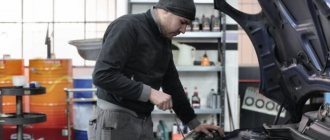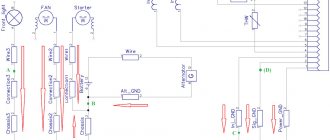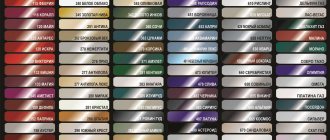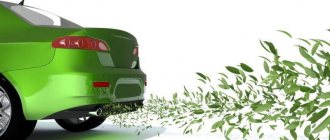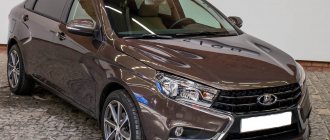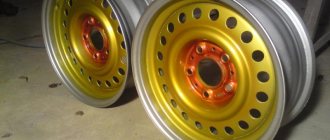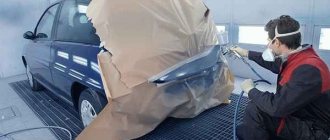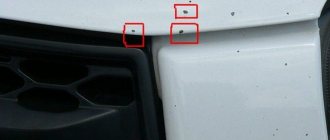Comments: no Published: 01/07/2016
Rating:
Tags:Car paintVarnishes and paint
Painting a car in a showroom is not a cheap pleasure. But you can do it on your own if you practice a little first and become familiar with the basic rules of work. It is also very important to calculate the correct amount of paint that will be needed for your car. Why this is so important and how to find out how much it costs to paint a car completely, you will find out further.
Material consumption for the machine as a whole and for individual elements
It should be noted right away that there is no clear answer to this question. Many factors play a role here:
- manufacturer of coatings,
- hiding power of paint,
- selected color,
- the size of the element or the car itself,
- color of the substrate or primer,
- transfer coefficient of the spray gun, etc.
Therefore, we will operate with approximate figures. For an average part: wing, door, etc., the enamel consumption is 150 ml, for a bumper you will spend, depending on its size, about 250-300 ml, for the hood you will spend about 400-600 ml of dye.
From this we can conclude that at 1 m? Approximately 200-250 ml of paint and varnish are spent. The varnish consumption is exactly the same (if you do not take into account the hardener and thinner). But provided that you apply it in 2 layers.
The material consumption depends, of course, on what car painting technology you chose, on the thickness of the layers and their number. In general, a medium-sized car (sedan) requires about 2 liters of base and the same amount of varnish. All figures are for materials undiluted. In other words, the hardener and solvent are not taken into account here.
Now to the question of how much paint is needed to paint a car, based on its type. You will need about 2 liters of acrylic composition. An average car will need about 3 liters of alkyd enamel. It should be said that this is only consumption on the outside of the body. If you are going to paint it inside, then the cost of paintwork materials will increase to 4 liters.
How to calculate the consumption of paint and varnish?
To calculate how much paint or varnish is needed to paint a car or its parts, you can use the average rate. According to approximate calculations per 1 sq.m. body, ¼ liter is spent. material. It follows from this that a vehicle will need 3.5 - 4 liters of paintwork.
As for the varnish, its consumption will be the same as the coloring composition (for a two-layer coating, the amount of substance must be multiplied by two). The amount of varnish also depends on the covering power of their base. Taking this parameter into account, in order to save on consumption, it is better to choose compounds made from synthetic resins. Nitro-combined and acrylic analogues “cover” the paint worse.
How long does spray paint last?
The question of what area of the car is enough for a 150-gram can of paintwork also does not have a clear answer. For example, manufacturers indicate a very wide range of this parameter: from 0.25 m? up to 0.5 m?. But manufacturers of paints and varnishes cannot give an exact answer, since the amount of consumption largely depends on you.
The cost of the composition will be significantly lower, for example, if the base is finely porous and well polished. This will also be facilitated by the fact that the color of the repaired area of the body matches the paint being applied as closely as possible. The consumption of varnish and paint may also depend on their temperature; too cold paint and varnish forms flowing “tears”.
Material costs are also optimal when old, well-sanded varnish is treated with paint of the same color.
The minimum consumption will be if a light coloring composition is applied to a gray-black base or dark paint to a white base, in this case their covering power will be justified.
But the situation with a light yellow dye on a dark primer is much more complicated, because here the covering ability of the corresponding pigment also plays a crucial role. Among other things, under the same conditions of body surface treatment, aerosol cans, even from the same manufacturer, may not have the same covering power.
Preliminary work to prepare the car for painting
Directly painting a car with your own hands takes 1/10 of the time spent on the entire operation, and the remaining 9/10 is occupied by preparatory work for painting. They represent the following sequence of actions:
- The first step is to clean the car from dirt, dust and grease stains using detergents and white spirit. Gasoline and solvents should not be used for this purpose.
- Then you need to remove from the body all parts that may interfere with painting. To do this, both bumpers, all headlights, the radiator grille, all devices for outdoor lighting, and antennas are removed.
- The next step is to clean up surface defects on the body. In good lighting, dents, chips, and scratches on the car's surface are identified and marked. Using a chisel and sandpaper, clean the marked areas to the metal surface. After completing the operation, remove dust again using a piece of cloth soaked in white spirit.
- Next, the surface is primed with a two-component acrylic primer, and all defects are puttied with polyester putty and primed again.
- We sand the primer with sandpaper and move on to painting.
Machine size
Of course, the larger the car, the more paint you will need to paint it.
p, blockquote 4,0,0,0,0 —>
p, blockquote 5,0,0,0,0 —>
For example, to paint a small subcompact car you will need less than 2 liters of undiluted paint, while painting an SUV with a large body area will require more paint. It is also necessary to consider whether the openings will be painted. This will also increase paint consumption.
p, blockquote 6,0,1,0,0 —>
Paint color and original body color
p, blockquote 7,0,0,0,0 —>
The amount of paint required to paint a car depends on what color the car will be painted and what the original color of the surface to be painted is. If the body panel has a color contrasting to the one being sprayed, then more paint will be needed. Colors such as yellow, red, and blue are low opaque, so more paint may be needed to cover the original color. If the paint has low coverage, then it is necessary to apply more layers to paint the substrate. For example, when painting with red and yellow paint, up to 10 or more layers may be required.
p, blockquote 8,0,0,0,0 —>
Colors such as black, white, and bright green have good hiding power.
p, blockquote 9,0,0,0,0 —>
If a car is repainted due to numerous minor defects and scratches that are sanded off during preparation of the body for painting, then less paint will be used than when changing the color of the car.
p, blockquote 10,0,0,0,0 —>
The color of the substrate will affect the final shade of the paint.
p, blockquote 11,0,0,0,0 —>
Note: Hiding power is the ability of paint, when sprayed, to completely cover the color of the surface, that is, to cover the color of the substrate with the sprayed color. Thus, the more opaque the paint, the less it will be needed to paint the part.
p, blockquote 12,0,0,0,0 —>
Painter experience
The amount of paint required to paint a car body also depends on the professionalism of the car painter. An experienced painter will set up the paint gun correctly and distribute the paint correctly. The paint should not be applied in the form of dust, but should spread well when it hits the surface. It is wiser to first paint over repair areas and replacement body panels that are a different color than the rest of the body. Then you can proceed to the step-by-step painting of all body parts.
p, blockquote 18,0,0,0,0 —>
Requirements for painting conditions
To carry out high-quality painting work with your own hands, you need to find a suitable room for it. The main characteristics in this case are purity and volume. There should be no dust in the room, as during the painting process it can settle on the body. Therefore, before starting work, the walls, ceiling and floor are cleaned and moistened. In addition, the contractor must have free access to the vehicle from all sides. To do this, you need a space around it of at least 2 m.
Base paint + varnish
If the car will be painted with paint that requires further varnish, then more varnish may be required than base paint. It is necessary to create a certain thickness with varnish, since it is a protective coating. For example, if it takes about 2 liters of base paint to paint the body, then 3 – 3.5 liters of varnish may be required. Even if a smaller amount of varnish is used, it is better to take it in reserve and dilute it not all at once, but as it is used. The remaining, undiluted varnish will be useful in the future when painting any car.
p, blockquote 19,0,0,0,0 —>
In general, the amount of varnish depends on the area to be varnished, and not on the amount of base paint. The amount of paint and varnish may be the same.
p, blockquote 20,0,0,1,0 —>
The amount of paint required to paint the entire car
If you use paint economically, you may need 2 kg of paint for the entire car. You need about the same amount of varnish.
p, blockquote 23,0,0,0,0 —>
p, blockquote 24,0,0,0,0 —>
Basically, 2–2.5 kg of undiluted paint is enough to paint a four-door sedan. Since the base paint is diluted 1 to 1 (1 liter of paint is mixed with 1 liter of thinner), you will get twice as much diluted paint.
p, blockquote 25,0,0,0,0 —>
If the car needs to be painted along with all the openings, then you will need 0.5 - 1 kg more paint. Since the base paint is usually diluted 1 to 1, the amount of paint diluted for spraying will be 2 times greater.
How much paint does it take to paint a car? Tuning vehicles costs money, and all owners want their car to meet all the requirements. You can paint the body yourself if you have experience working with materials, the skills to calculate a sufficient volume, and select the appropriate substance.
For finishing in the garage, a base is used that is varnished. Acrylic enamels have a good shine due to their composition, so they can be varnished as desired. It is more difficult to work with red, yellow, and blue colors - you have to apply several layers to paint over the original shade.
Main stage
The body is now being painted. Naturally, you first need to select the paint material of the required color and prepare it in accordance with the manufacturer’s instructions. Using masking tape, cover body parts that are not to be painted with paper. The working surface of the body is wiped with a rag moistened with white spirit.
A spray gun is used as a tool for applying paint. Processing of the body begins with the roof. Throughout the work, the tool should be kept 15-25 cm from the surface being treated and moved with smooth back-and-forth movements. Painting is carried out in 2-3 layers with breaks of 15-20 minutes between them. After finishing the work, the car is left to dry for 24-36 hours at a temperature of 20°C.
Painting of hanging elements is as follows:
- removed body elements of the VAZ 2115, such as moldings, sills, both bumpers, are painted separately and installed after drying;
- Previously, body plastic elements, for example, a bumper, are washed first with water and detergent, then with a solvent. After this, remove the resin and pick off the peeling paint;
- The next step is to sand the bumper. To do this, use P120 sandpaper. In the process, corners and steps are smoothed out;
- large defects in the form of cracks are eliminated by boiling, and small ones - with putty;
- Then the surface of the bumper is matted with the same abrasive. Then the bumper is primed in several layers. A day later, the surface is sanded with abrasive paper P320 - P40;
- after this, apply 2 thinner layers and grind with abrasive P400 - P500;
- After cleaning and degreasing the bumper, paint is applied in 2-3 layers at intervals of 5-10 minutes, and 2 layers of varnish are applied on top of them.
What to consider when calculating
Automotive paint is expensive, so materials are calculated. If you don’t buy enough ingredients, you’ll have to buy more, but the shade will be different.
The following parameters are taken into account:
- Car size.
- Color of parts and paint.
- Quality of material.
- Model of a spray gun.
- Professional skills.
Hiding power is the ability of the composition to cover the original shade of the surface.
- A small runabout will require up to 2 liters of solution, an SUV will require a lot of paint, and finishing openings increases consumption.
- The initial color affects the amount of finishing materials.
- Consumption increases if the shades are contrasting.
- The number of layers increases if the paint has low coverage.
- Red and yellow are often applied up to 10 times.
- White, black, bright green have high hiding power.
- Restoration will require less finishing materials than changing color.
Each manufacturer creates mixtures using its own technology, so the composition may vary.
The model of the spray gun affects the consumption; HVLP devices transfer mixtures well to body parts; for high-quality devices this figure corresponds to 75%. All liquid gets onto the part and does not scatter to the sides.
Consumption is determined by the experience of the painter, who knows how to set up the spray gun and dilute the mixture. Materials flow over the surface rather than settling on it like dust. First of all, restored areas and new body elements are processed, then stage-by-stage finishing is carried out in other places.
How to make the correct calculations for varnish and paint
The above factors and manufacturer's advice affect the consumption of mixtures during operation. Solvent is added to the undiluted base before carrying out work.
- The volume of solvent is 20% of the base, but each type of enamel has its own proportions.
- Average figures for finishing are 200-250 ml of enamel and the same amount of varnish.
- A passenger car requires approximately 3 liters, and a gazelle – up to 5 liters.
- When painting elements on 2 sides, you will need 2 times more mixture.
- Acrylic is consumed 60% less than alkyd.
Paint consumption in cans
An economical option when painting a car is a can of automotive enamel. In addition, using a can is very convenient when painting individual parts.
In this situation, as in the case of ordinary paint, there are only approximate cost estimates. The table shows approximately how much varnish and spray cans are needed for painting different car parts.
| Detail | Aerosol quantity | varnish |
| Front, rear bumper | 3 pcs. | 350 ml. |
| Front, back door | 3 pcs. | 250 ml. |
| Roof | 4 things. | 400 ml. |
| trunk lid | 3 pcs. | 300 - 400 ml. |
| Hood | 3-4 pcs. | 400 ml. |
| Wing (front, rear) | 2 pcs. | 250 ml. |
| Threshold | 1 PC. | 100 ml. |
| Trunk lid hatchback, jeep | 3 pcs. | 300-400 ml. |
| Side racks | 1 PC. | 100 ml. |
| Side mirror | 1 PC. | 100 ml. |
Taking into account all the above nuances when painting a car, you can reduce the likelihood of overuse of paint and calculate the approximate amount of material required. Of course, the main criterion for paint consumption is the size of the machine and the viscosity of the material itself.
